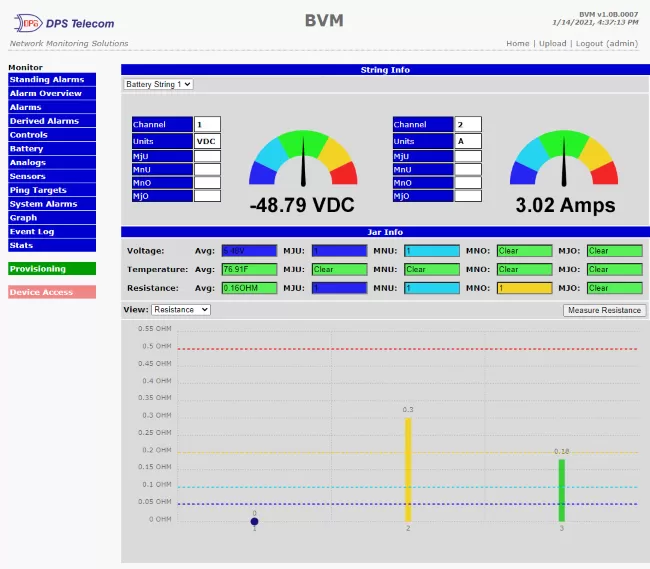Check out our White Paper Series!
A complete library of helpful advice and survival guides for every aspect of system monitoring and control.
1-800-693-0351
Have a specific question? Ask our team of expert engineers and get a specific answer!
Sign up for the next DPS Factory Training!

Whether you're new to our equipment or you've used it for years, DPS factory training is the best way to get more from your monitoring.
Reserve Your Seat TodayAn uninterruptible power supply (UPS) is one of the most important elements in data centers. That's why multiple companies depend on them to provide reliable power for their critical equipment in case commercial power failure happens or some other kind of power disruption.
Without a reliable UPS system, your network is at risk of suffering outages, voltage sags, and other issues that will cause downtime and can even damage your gear. Monitoring your entire system with a UPS monitoring tool keeps your entire system protected. If you experienced this problem, you know just how expensive it can be.
It stands to reason, then, that organizations need to know when their UPSs are at risk of failing. For that, UPS monitoring and remote control are vital.
A UPS battery monitoring system essentially provides you with a better level of testing than what a technician would perform, but continuously. Proactive testing and maintenance are the keys to ensure a long life cycle.
A UPS monitoring system will allow you to keep track of the different metrics such as voltage, current, battery status, so you can make sure your batteries are always up, available, and working. Following the industry's best practices is crucial, though, to ensure dependable network uptime.
Let's take a look at some of the industry's best practices when it comes to UPS remote monitoring and management.

UPS battery failure is one of the lead causes of network downtime. Deploying a monitoring system is only the first step to prevent this issue, you also need to make sure that your chosen system is efficient. An effective monitoring system will follow the industry's best practices and give you features that can make the difference between reliable uptime and disastrous downtime.
The following are some of these best practices to keep in mind when choosing a monitoring system for your company.
Think about your car's battery - they have a way of failing with little to no warning. Wouldn't it be good to know when your battery is about to die?
That's exactly what remote monitoring devices do for your company's UPS system. But, in the case of UPS batteries, a failing battery puts extra strain on all the other batteries in the string. It will draw power from the other batteries, decreasing their lifespan.
The UPS lifespan can be affected by many different aspects, such as:
So, it's actually surprising that many companies still don't monitor their batteries or believe that monitoring at the string level is sufficient. But it is not. Keep in mind that batteries need to be monitored at the individual cell level.
A failing battery puts additional strain on all the other batteries in the string. It will draw power from the other batteries, which decreases their lifespan.
Not monitoring your batteries at the cell level will leave you unaware about a failed battery taking the whole string down with it. Without notice, there will be a complete network downtime. This can be very costly because you'll have to replace all your batteries prematurely.
So, to make sure this doesn't happen, you need to have a dedicated battery monitoring system, such as the DPS BVM (Battery Voltage Monitor), connected to each battery cell. The BVM attaches directly to battery posts to report precise voltage and temperature data for every individual jar. This way, you'll be provided with automated performance measurements.
Your remote battery systems should also be able to store and analyze the information it collects. It should give you the ability to capture to export log files for analysis to identify problematic trends, such as when a battery is on a downward spiral but months before it's in danger of failing.
Event logging allows you to track the timing and sequence of events leading up to an issue. This way, you'll know when your battery is "getting sick" so you can replace it before it spreads to all other batteries in the string.
Many companies invest in remote monitoring systems to keep an eye on their mission-critical equipment. If that's your case, then having a battery management system that supports SNMP communication can be valuable.
Why? Because with the SNMP protocol, you can consolidate all the remote monitoring systems you have under one single umbrella. This also allows you to monitor the performance of any UPS device from any vendor.
The T/Mon LNX is a multiprotocol master station that allows you to monitor and manage all the monitoring devices and equipment you have deployed. You won't have to struggle with multiple different systems and their interfaces. Everything will be displayed in an intuitive, visual web interface.
Your monitoring solution, like a NetGuardian RTU, should also support the remote control of your UPS batteries. By wiring the NetGuardian's control relays to your equipment, you can remotely reboot UPS controller units to reestablish availability when they "freeze up", "jam", or otherwise need to be power cycled...
This would allow you, for example, to remotely reboot UPS units to reestablish availability without having to send a technician in an expensive truck roll.
You'd also be able to schedule automatic reboots and shutdowns of UPS batteries and connected equipment.
Upgrading your monitoring system with new firmware releases is a great option to keep your system updated and to get new important features. But, having to dispatch your techs to the field to perform these upgrades, or having to ship your monitoring device back to the manufacturer is not cost-effective - in fact, it can turn out to be a big waste.
So, make sure your monitoring system allows you to download new firmware releases from your vendor's website. This way, you can install those updates over LAN from your office. Also, it's a big bonus if you can get these firmware updates for free.
Although there are many battery monitoring devices available in the market today, the number of battery parameters they monitor can vary significantly from one system to another.
The BVM G3 is an efficient remote monitoring device that provides a comprehensive, proactive UPS monitoring approach. It monitors the battery parameters that IEEE 1491 recommends to be measured. These include:
The BVM G3 has a web interface that gathers and displays your battery monitoring parameters on one intuitive screen. It also allows you and your team to view your current battery health, as well as trends over time. This gives you a better understanding of your battery life cycles, as well as an added level of security that you know you'll be immediately alerted to when an issue happens.

The BVM G3's capabilities go beyond just monitoring your batteries. It also gives you 8 discrete alarm points, 8 analog alarms, and 3 control relays. This way, you can remotely monitor your mission-critical equipment as well.
With the BVM G3, you can set thresholds so you can get alerted when a battery is about to fail. This is a clear step up from scheduled UPS maintenance visits because you won't have to be reactive to issues anymore. You'll be able to proactively maintain the health of your UPS batteries, making sure they last throughout their entire life expectancy.
Having to keep track of remote UPS batteries is a challenging task. You need to make sure you can rely on them to be always available when you need them the most.
That's where a competent battery management system comes into play. Its objective is to prevent battery failure.
Having regular preventative UPS inspections is important, but a battery monitoring system will provide you with a more thorough understanding of the overall UPS condition. And, to ensure you're getting all the details you need, you must follow the industry's best practices explained in this article.
At DPS, we specialize in remote monitoring systems manufacturing and we have plenty of experience designing and deploying battery management systems. So, we are glad to help you get more out of your UPS battery investment.
Reach out to us and let's have a more in-depth discussion about your battery management solution and how the BVM G3 can help improve your network's efficiency.

Morgana Siggins
Morgana Siggins is a marketing writer, content creator, and documentation specialist at DPS Telecom. She has created over 200 blog articles and videos sharing her years of experience in the remote monitoring industry.